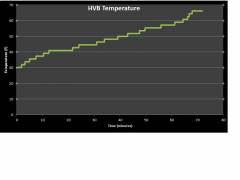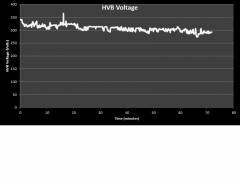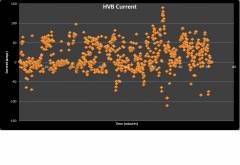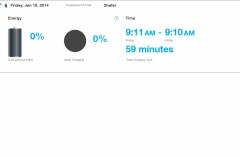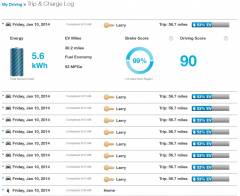

larryh
Fusion Energi Member-
Posts
1,462 -
Joined
-
Last visited
-
Days Won
152
Content Type
Gallery
Profiles
Forums
Everything posted by larryh
-
The following chart is for the HVB Temperature in degrees Fahrenheit for the same commute. The outside temperature was 36 F. The first 12 minutes were in EV Now mode. The last several minutes were also primarily EV mode. The temperature changed more slowly when the ICE was on. Most of the temperature change occurred in EV mode. The SOC of the HVB was 97.7% at the beginning of the trip and 17.7% at the end of the trip.
-
From the album: Car
This plot shows the HVB current for a 60 mile commute. The outside temperature was 36 F. -
The following chart is for the HVB Voltage for the same commute. You can see that it decreases with time as the battery is discharged.
-
From the album: Car
This plot shows the HVB voltage for a 60 mile commute. -
I recorded some OBD II sensor data from the HVB for my 67 mile commute home today. The interval between each data point is five seconds. The commute took about 70 minutes. The positive values represent current flow out of the HVB. Negative values are current flow into the battery, e.g. regenerative braking. You can see the current ranged from -112 to 139 amps.
-
From the album: Car
This plot shows the HVB current for a 60 mile commute. When current flows into the battery, e.g. regenerative braking, the current is negative. -
I made my 57 mile commute home today. The HVB temperature when I started was 30.2 F. The outside temperature was 36.0 F. The HVB temperature eventually reached 66.2 F at the end of the trip about 70 minutes later. It didn't rise very fast when the ICE came on. Most of the temperature rise was in EV mode. I'll see how much it cools down tonight for the morning commute.
-
I can probably estimate the savings in gas for a 5 degree F increase in HVB temperature. At 70 F, I see around 25 miles of EV range. At -15 F, I see about 11 miles of EV range. So for every 1 degree decrease in temperature, the range decreases by about 14 miles / 85 degrees = 0.16 miles / degree. A 5 degree increase will increase EV range by about 5 * 0.16 = 0.8 miles. I would expect at least 40 mpg for my commute home in hybrid mode when it is in the 20s, so that would mean I would save 0.8 miles / 40 mpg = 0.02 gallons of gas. That saves me $0.06 in gas. However, I used 1.5 kWh * $0.10 = $0.15 of electricity (actually, as I mentioned above, the electricity costs me nothing). So preconditioning with the 120 V charger doesn't even save any money.
-
I plugged in the EBH for three hours after preconditioning. The engine coolant temperature rose from 19.4 F to 100.8 F. The EBH also warmed other components under the hood, apparently from the heat radiating from the engine block. The generator inverter temperature was raised to 42.8 F and the motor inverter temperature was raised to 44.6 F. The transmission fluid was 59.9 F. So the EBH does far more good than preconditioning. The EBH requires about 1.3 kWh of electricity for 3 hours. That costs about $0.13 (actually it is free for me). If it saves just 0.04 gallons of gas, then it is worth it.
-
This morning it was 19 F. I preconditioned the car using the 120 V charger. Preconditioning took 1 hour. As usual, the interior felt no warmer after preconditioning had completed. I recorded the following measurements before and after preconditioning: Parameter Before After HVB Temp 19.4 F 24.8 F HVB SOC 98.4% 95.8% HVB Volts 341.5 V 341.6 V Coolant Temp 19.4 F 19.4 F Interior Temp 23.0 F 39.2 F Preconditioning warmed up the HVB battery by 5.4 degrees F. It required about 1.5 kWh of energy to do that. Preconditioning in cold weather with the 120 V charger is probably a complete waste of energy. I doubt that you can recover an additional 1.5 kWh of energy from the battery by warming it a mere 5.4 degrees F. In addition, the cabin interior was no warmer than when preconditioning started so I don't think you are saving the HVB from using much energy to heat the cabin. I'm not sure how the car is measuring interior temperature, but it thinks it warmed up the interior by 16 degrees F. Also, the coolant temperature that is being measured must be coming from some other place than what it shown in ET mode. Preconditioning did not change the coolant temperature. While charging the car, I observe the HVB battery voltage and current to be 341.5 V and -3.0 amps. Of the 1365 kW of power being consumed by the 120 V charger, 1024 kW is making it into the battery. That is 75%. I wonder if the efficiency would be better if the HVB were warmer. Note that I didn't actually look at the Kill-A-Watt meter to verify the power being consumed. So I'm not sure if the 75% number is correct.
-
I guess I do have the ability to download data with the Torque application using an inexpensive ELM327 OBDII scanner, if only I could figure out how to do it. It shows DTCs and normal sensor information such as coolant temperature, engine rpms, etc. I have programmed it to show HVB SOC, HVB Temp, HVB Voltage, HVB Current, Inverter Temps, and others. This afternoon, it was 19 F. The HVB battery temperature was also 19 F. I drove around for a couple of miles in EV mode. The HVB temperature only warmed up a few degrees to about 23 F. So I suppose when it is below zero, the HVB temperature is also below zero. That explains why the ICE starts when it is below 0 F. The HVB probably can't generate enough power at that temperature. I wonder whether the ICE turns on or not is based on the HVB temperature in EV Now mode.
-
I asked the author why cold weather performance of tires has a much greater impact on EVs than gasoline powered vehicles, i.e. -13% vs -4% loss in range. I received the following response: It's the same resistance applied on less energy available, so the impact is much more noticeable. So there are no differences regarding performance of tires used on EVs vs gasoline cars. But if the effect of increased rolling resistance on tires has more impact on EVs, then I would expect the increased aerodynamic drag to have a similar impact on EVs. But according it the article the impact is -6% vs -5% loss in range. So I am still confused by the author's response.
-
So according to that article, half of my energy loss results from increased rolling resistance of the tires in cold weather? They must be using the Nissan Leaf as the EV for comparison which, I believe, has the same tires that we have, i.e. the Michelin Energy Saver tires. Going from 70 F to 0 F, my MPGe in EV mode goes from about 150 to 103. [i use very little climate control after preconditioning the car. So that loss should be minimal.] That is a 31% reduction. So I am loosing 13% to the tires alone? The low rolling resistant tires don't do well in the cold? The gasoline cars probably use normal tires. The cold weather affects them much less? Would pumping up the tires to 50 PSI help? They are at 35 PSI as specified on the door at the moment. Are the drivers in the study maintaining tire pressure in the winter? Are there better tires for winter to improve mileage?
-
Preconditioning this morning with the temperature at 34 F and using the 240 V charger, the coolant temperature was 38 C prior to the GO time.
-
Today, the temperature is 37 F. Preconditioning only heated the coolant to 16 C, or 60 F, by the GO time. That's not going to warm the car's interior much.
-
Thank you for the above information. It would be nice if it would record things like MPGe and HVB temperature. Last week, when I used the EBH for four hours, I noticed that the coolant temperature reached 30 C. During the last hour, I also preconditioned the car with the 120 V charger. The coolant temperature remained at 30 C during the last hour before the GO time. So I assume that when preconditioning began, the "isolated" loop was activated and the heating element now began warming the coolant in the "Isolated loop" which was already at 30 C (86 F). However, for the hour that preconditioning occurred, the coolant temperature did not change. It appears the 120 V charger was only able to maintain the coolant temperature at 30 C during preconditioning and couldn't warm it any further. The car probably blows in cold outside air through the heater core during preconditioning. The coolant isn't warm enough to warm the cold outside air much. In addition, the cold outside air is probably cooling the heater core significantly. It appears, the 120 V charger just can't keep up. The EBH does a better job of warming the engine coolant than preconditioning with the 120 V charger. The EBH uses 440 Watts * 3 hours = 1.32 kWh. That is the same amount that is used by the 120 V charger preconditioning the car for one hour. The EBH doesn't have to contend with the climate control blowing cold below zero air through the heater core cooling the coolant faster than the 120 V charger can heat it.
-
I do not have a scan gauge. I wish they made a device that would allow the OBD II data to be downloaded to a computer to analyze it. Someone should provide an application for MFT that does that. I am using Engineering Test Mode: http://fordfusionhybridforum.com/topic/6749-engineering-test-mode/
-
The temperature sensor for the coolant seems to be in the "Isolated" loop containing the heating element and the heater core. So this morning, I turned on climate in EV Now mode, with the ICE off, and observed the coolant temperature using ET mode. I left the car parked. The temperature this morning was 26 F. I observed the following readings: Time Temp C Climate On/Off 7:09 -4 On 7:10 13 On 7:11 33 On 7:12 45 On 7:13 52 On 7:14 56 On 7:15 58 On 7:16 60 On 7:17 61 On 7:18 60 On 7:19 61 On ------------------- 7:20 66 Off 7:21 66 Off ------------------- 7:22 52 On 7:23 56 On 7:24 57 On -------------------- 7:25 68 Off 7:26 70 Off 7:27 70 Off 7:28 69 Off 7:29 67 Off 7:30 66 Off ------------------- 7:31 48 On The heating element heats the coolant to around 60 C. If climate is turned off, the sensor temperature increases initially before falling. The coolant must no longer circulate. In addition, the sensor must be close to the heating element or the warm coolant rises up to the sensor which is near the top. When turning climate back on again, the coolant temperature falls rapidly as the coolant starts circulating again. It is unclear whether this is due to mixing of coolant from outside the "isolated" loop with that inside the "isolated" loop or the coolant inside the "isolated" loop has cooled off with the heating element turned off. Leaving climate off for two minutes, the temperature fell to 52 C. With climate off for 5 minutes, it fell to 48 C. I am inclined to believe that the cold coolant from outside the "isolated" loop mixed in with that from the "isolated" loop. The temperature drop after 2 minutes was 8 C, and after 5 minutes it was 9 C. If that is the case, you don't want to turn climate on and off frequently unless all the engine coolant is heated. I will have to try turning off climate for a shorted period of time to verify.
-
I found a block diagram showing the cooling system here in the section entitled HEV/PHEV Cooling System Diagnostics: https://qa2k3.motorcraftservice.com/vdirs/diagnostics/pdf/OBDSM1303_HEV.pdf This is an excerpt from the document: The cooling system in the Plug-in Hybrid has been designed to include two functional cooling loops. This system is designed to maximize cooling efficiency when the vehicle is running on either the gas engine or the electric motor. The system operates in one of two different modes. The first mode is the main or "combined" cooling loop mode which provides coolant flow through both the gas engine and the cabin heater core. While in this loop, both the gas engine and an electric heater can be used to maximize the heat transfer to the coolant thus providing both an increase in the engine metal temperature and heat for the vehicle cabin. The second cooling mode is the "isolated" loop mode where coolant flow through the cabin heater core is isolated from the engine block. This loop is intended to provide cabin heat when the gas engine is not running. Coolant flow is maintained in the "combined" loop by default (isolation valve de-energized), and by energizing the isolation valve coolant flow is maintained in the "isolated" loop. So preconditioning uses the isolated loop where the coolant is circulated through the electric heater and heater core, isolated from the engine block. An Engine Block Heater heats the engine block and coolant outside of the isolated heater core loop and thus will not help in heating the cabin during preconditioning. Preconditioning and the Engine Block Heater operate independently heating different parts of the car: preconditioning heats the car's interior and the Engine Block Heater heats the engine itself. There are two electric pumps, one for the main coolant loop and one for the isolated loop for the heater core. I wonder what happens when we turn climate control off. I assume that the pump for the isolated heater core loop turns off. But then is the heater core coolant no longer isolated when climate control is off? Does it mix with the cold engine block coolant that has not been warmed by preconditioning? If the isolated loop is no longer isolated, then the heater will have to work harder when climate control is turned back on to heat the colder coolant that has now entered the isolated coolant loop for the heater core.
-

2013 Fusion Energi Suffers from Sloppy Programming
larryh replied to murphy's topic in Lounge - Fusion Energi
Is anyone familiar with the performance of preconditioning in other PHEVs in cold weather? If it is around 10 F, how long does preconditioning take? What temperature is the car's interior after it completes? And how much electricity does it consume? -
Charging just completed. The entry in the Trip and Charge Log for this charge is also incorrect. I charged from 9:11 am to 2:45 pm. Time is flowing backwards. The charge time was -1 minute.
- 29 replies
-
- SYNC
- MyFord Mobile
-
(and 2 more)
Tagged with:
-
From the album: Car
MFM is showing incorrect charge information in the Trip & Charge Log. -
At the MFM web site, I see my trip this morning is repeated nine times in the Trip and Charge Log. That's not going to help my rankings. It should repeat one with a better driving score and higher percentage EV. I don't think the problem with duplicate entries has been fixed yet.
- 29 replies
-
- SYNC
- MyFord Mobile
-
(and 2 more)
Tagged with:
-
From the album: Car
My latest trip is recorded nine times in the Trip and Charge Log at MFM. -
The federal plug-in hybrid tax credit can only be used to reduce the income tax that you owe. If you do not owe more taxes than the credit, you do not get a refund for the amount the credit exceeds taxes. See lines 20-23 of form 8936. The same is true for the credit for installing a charging station. In addition, the credit for a charging station is subject to AMT. The plug-in hybrid tax credit is not subject to AMT.

